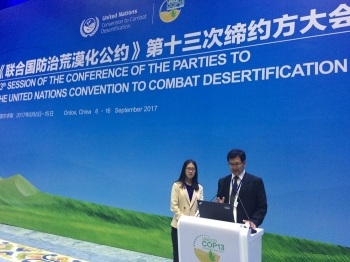Over 5,000 delegates attend UN convention to 'Combat Desertification' India commits itself to global efforts to save the Earth
By Reach Ladakh Correspondent
CHINA,
Oct 03, 2017

CHINA :
\r\nThe 13th session of Conference of Parties to the United Nations Convention to Combat Desertification (UNCCD) took place from 6-16 September in Ordos, Inner Mongolia, China.\r\n
\r\n\r\n \r\n
\r\n\r\nZhang Jianlong, Minister of State Forestry Administration, China, inaugurated the first United Nations Conferences of the Rio Conventions to be hosted in China. More than 5,000 delegates from 196 countries attended the conference, including 80 ministers from affected countries. \r\n
\r\n\r\n
\r\n
\r\n\r\n
\r\nThe Indian delegation was led by Jigmet Takpa (IFS), Joint Secretary, Ministry of Environment, Forests and Climate Change (MOEF&CC) led and included Satya Pal Vashishth (IFS), DIG Forests, MOEF&CC, Surabhi Rai (IFS), Director, Ministry of Rural Development and representatives of numerous scientific institutions and civil society organisations. \r\n
\r\n\r\n
\r\n
\r\n\r\n
\r\nThe conference included two field trips to help participants observe Chinese effort and technology to combat desertification and reclaim degraded lands.\r\n
\r\n\r\n
\r\n
\r\n\r\n
\r\nGlobally, 169 countries are affected by desertification. More than 2 billion hectares of productive land are estimated to be degraded, which accounts for 1/3rd of the world’s land. More than 1.5 billion people are estimated to be living off the degraded land. Based on various studies, the annual loss of 12 million hectares of productive land on average is expected to worsen in the face of increasing, frequent and recurrent severe droughts unless joint action is taken to combat and mitigate these processes and their impacts. \r\n
\r\n\r\n
\r\n
\r\n\r\n
\r\nIn India, around 328 million hectares of its total geographical area of 96.40 mha (29.43% of TGA) is estimated to be undergoing land degradation. Around 82.64 mha or 25.20% of India’s TGA is classified as desert, semi-arid and dry humid, while drylands constitute 228.3 mha or 69.60% of India’s TGA. However, this needs to be contextualised by the fact that India covers 2.4% of the world’s geographical area while being home to 16.7% of the world’s human population and 18% of the world’s cattle population.\r\n
\r\n\r\n
\r\n
\r\n\r\n
\r\nThus, there is immense pressure on scarce land resources, which underlines the urgent need, and challenge, for combating desertification and rehabilitation of degraded lands. \r\n
\r\n\r\nOn September 11, Jigmet Takpa announced India’s willingness to join the UNCCD Land Degradation Neutrality Target Setting Programme (LDN TSP) at a high-level ministerial meeting. India is now the 112th country to join the LDN TSP.\r\n
\r\n\r\n
\r\n
\r\n\r\n
\r\nJigmet Takpa said, “Desertification and land degradation are very critical issues that affect everything from biodiversity, economics, livelihoods, society, climatic cycles and gender empowerment. The government of India is committed to mitigating this challenge at different levels in the country, while also working together with other countries and partner agencies to address this problem at the global level.”\r\n
\r\n\r\n
\r\n
\r\n\r\n
\r\nTakpa held several meeting with the UNCCD Secretariat and partner agencies such as the Global Environment Facility (GEF), Global Mechanism (GM), and LDN Fund on issue of financing and supporting projects to combat desertification, land degradation, and drought in India; especially in India’s hot and cold deserts as well as dry and degraded lands. The funding mechanisms are still being worked out to support efforts to mitigate degraded land. \r\n
\r\n\r\n
\r\n
\r\n\r\n
\r\nThe conference ended with an agreement from 113 countries to specify concrete targets, with clear indicators to reverse degradation and rehabilitate more land. Countries also agreed on a new global roadmap to address land degradation. \r\n
\r\n\r\n
\r\n
\r\n\r\n
\r\nThe new UNCCD 2018-2030 Strategic Framework is the most comprehensive global commitment so far to achieve Land Degradation Neutrality (LDN) to restore the productivity of degraded lands, improve the livelihood of more than 1.5 billion people, reduce the impact of drought on vulnerable populations, secure socio-ecological resilience and achieve biodiversity conservation. \r\n
\r\n\r\n
\r\n
\r\n\r\n
\r\nThe conference also witnessed the birth of the first global private sector fund dedicated to implementing the UN’s Sustainable Development Goals. This new entity is called the Land Degradation Neutrality Fund (LDN Fund) and has an initial capitalisation target of USD 300 million. It will be a source for transformative capital and bring together public and private investors to fund projects to restore degraded lands, which bring about environmental, economic and social benefits.\r\n
\r\n\r\n \r\n
\r\n\r\nA new landmark publication, The Global Land Outlook was unveiled at the conference, which focuses the spotlight on the need for urgent and swift action.\r\n
\r\n\r\n \r\n
\r\n\r\nMore than 80 ministers from around the world issued the Ordos Declaration, urging countries to step up efforts on all fronts to tackle desertification, which remains one of the planet’s most pressing global challenges. The declaration also highlighted action required to address three new emerging issues linked to increasing land degradation: drought, sand and dust storms and migration.\r\n





